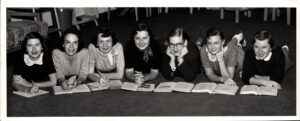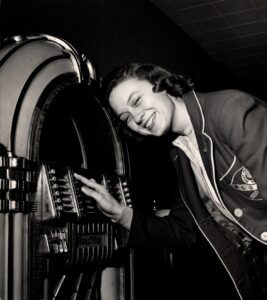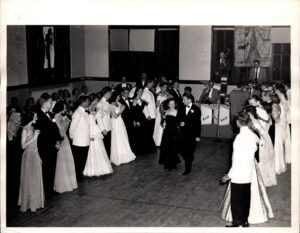When the State Normal and Industrial School opened its doors in October of 1892, there was barely enough room for the 176 students who came through them. By the end of the year, the girls’ school had 223 students spilling out of the dormitories. This overflow resulted in some students rooming in auxiliary dormitories, while others boarded with neighborhood families. Most of these students dined at the college’s dining hall, which was located in Brick Dormitory. The only other students who lived off of the main campus were the small number of girls who lived at home. Initially, there were very few of these “Day Students.” In 1904, there were forty-six students attending classes at State Normal, but living at home.
Because the “Day Students,” or “Town Students,” did not live in the dorms, they tended not to be as involved in groups, and often felt that they had second class status on campus. As Day Students had their own particular needs and concerns, they were encouraged to start their own organization, in the hope that it would encourage them to become more involved on campus. In the early years, these students were represented in the school’s Student Government Association, but they were not given formal recognition until 1929. In that year, the Day Students Association was founded, which allowed the students more representation in the school’s student government. At this time, the group was given a special room in the Students’ Building that was designated for study and relaxation. Unfortunately, the space had very few amenities which would have made life easier for students who lived off campus. It had sparse furniture and no lockers, resulting in the students having to carry their books all day. There was also a parking problem for commuting students, who had to compete for a limited amount of spaces with faculty members.
As the college continued to grow, students continued to live both on and off campus and there continued to be an organization for commuting students. In 1933, the Day Students’ Association changed its name to the Town Students Association. Membership included all women who lived off campus, and the group’s constitution reflected their desire “to participate more fully in college activities, and believing that student government develops self-control and instills loyalty in students.”
In the years after World War II, college enrollment began to swell. At that time, almost ten percent of the student populations lived at home. By 1949, 220 town students were enrolled at Woman’s College (now UNC Greensboro). Although these young women had only minimal participation in campus organizations, they occasionally would socialize together in the Day Students’ Room. In an attempt to draw these students further into college life and create deeper connections with on-campus students, administration allowed each town students to join a residence hall. This plan was not a great success and most town students preferred to return home after class or to gather in the Day Students’ Organization room, which was now located in Elliott Hall. Instead, to further the feeling of inclusion in typical campus activities, the Organization decided to hold a dance. This type of activity allowed the students to have a typical college experience without living on campus.
When Woman’s College became a part of the University of North Carolina system in 1963, the school became co-ed and the commuting community grew even larger. Indeed, most of the rise in registration was due to local enrollment. Two years later, the Town Students’ Association had its first male officer, Anthony Thompson. This was not popular with many of the female members who were still becoming accustomed to male students on campus. The organization’s new handbook set their goals as: “to inform the Town Students of student government activities; to unite the town students, and to link more closely community students with dormitory students.” Recognizing that meeting attendance was one of the most challenging aspects of the organization, members were requested to check their mailboxes every day for organization news and to attend all meetings, which were held in Elliott Hall.
By the 1970s, the organization attempted to appeal to a broad and diverse range of members by sponsoring a car rally and book exchanges. The early 1980s saw a population of approximately 6000 off-campus and commuter students at UNC Greensboro, and the Town Student Executive Board planned engaging and creative activities. Dues payed for activities included breakfasts and lunches for the members, as well as trips to local breweries and dinner theaters, as well as career planning events.
In 1983, the Town Students Association became the Commuting Students Association, incorporating students who traveled to campus from out of town. The average age of this group was twenty seven years old. Sadly, the renamed organization never really garnered support from the student body, and by 1993, their main function was to supply monthly deli lunches for its members. As the commuting population grew larger, there became less of a formal need for an organization to help the students assimilate to campus life. These students would now help to shape the culture and personality of the school.
By Kathelene McCarty Smith


